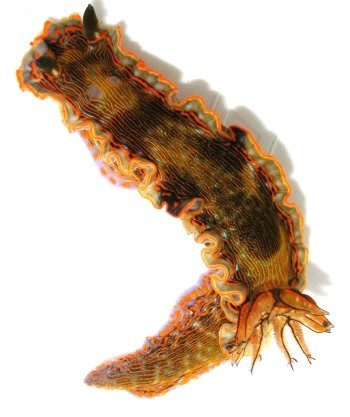
Hypselodoris juliae
Dacosta, Padula & Schroedl, 2010
Order: NUDIBRANCHIA
Suborder: DORIDINA
Superfamily: EUDORIDOIDEA
Family: Chromodorididae
DISTRIBUTION
Hypselodoris juliae has been reported only from near Rio de Janeiro, Brazil. However I have little doubt that Hypselodoris sp. 4 is conspecific. If that proves to be the case then H. juliae, has a range from Brazil to Florida.
PHOTO
Upper Photo: Holotype. MNRJ 10940, 57 mm alive, Praia das Conchas, Cabo Frio, state of Rio de Janeiro, Brazil, intertidal, 14 November 2004. Photo: V. Padula.
Tha animal is elongate with a relatively narrow mantle skirt down each side. The edge of the mantle is sinuously folded. The mantle is translucent with a purplish or greyish tinge. There are many thin yellow to orange longitudinal lines running down the mantle and along the sides of the body and foot. There is an orange/yellow line at the mantle edge, bordered both above and below by a thin opaque white line. Inside this border is a wide translucent grey/purple submarginal space before the longitudinal oral lines. In this space a single spaced row of whitish subepidermal mantle glands can be seen running around the mantle edge.
The longitudinal orange lines are each edged thin dark brown line. There are also a number of irregular dark brown patches arrange on the mantle, About midway between the gills and the rhinophores there is a dark brown patch on each side at the mantle edge. It contains a number of orange/yellow spots. The edge of the foot is translucent purple or grey with scattered orange spots and short lines.
There are approximately 10 simple gills. They are translucent whitish with a dark brown edge. In some cases the upper edge also has a submarginal orange/yellow line as well. The rhinophore clubs are translucen with varying degrees of dark brownish pigment, sometimes making the whole club brown while other time the brown is restricted to bands at the tip.
While the authors have some doubts about whether Hypselodoris sp. 4 is conspecific, I feel there is little doubt it is the same species. If that proves to be the case then H. juliae, reported only from near Rio de Janeiro, Brazil, has a range from Brazil to Florida, where Hypselodoris sp. 4 has been found.
Previously known on the Forum as Hypselodoris sp. 4.
- Dacosta, S., Padula, V. & Schroedl, M. 2010 A New Species of Hypselodoris and a Redescription of Hypselodoris picta lajensis (Nudibranchia: Chromodorididae) from Brazil. The Veliger, 51: 15-25
Rudman, W.B., 2010 (May 31) Hypselodoris juliae Dacosta, Padula & Schroedl, 2010. [In] Sea Slug Forum. Australian Museum, Sydney. Available from http://www.seaslugforum.net/factsheet/hypsjuli
Related messages
-
Hypselodoris juliae from Brazil [2]
From: Peter Wirtz, June 3, 2010 -
Hypselodoris juliae from Brazil [1]
From: Vinicius Padula, May 31, 2010 -
Hypselodoris sp. 4 - Post Mating
From: Linda Ianniello, May 16, 2003 -
Hypselodoris sp. 4 eggs
From: Linda Ianniello, September 27, 2002 -
Food of Hypselodoris sp. 4
From: Anne DuPont, October 6, 2001 -
Re: Hypselodoris sp. 4 from Florida
From: Linda Ianniello , October 5, 2001 -
Food of Hypselodoris sp. 4
From: Anne Dupont, September 25, 2001 -
Hypselodoris acriba or H. edenticulata?
From: Anne DuPont, September 25, 2001 -
Hypselodoris acriba or H. edenticulata
From: Anne DuPont, August 21, 2001
